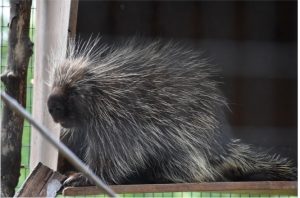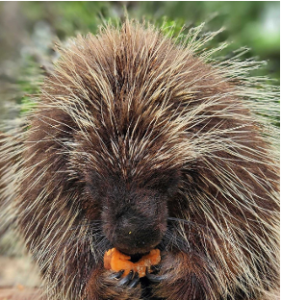

 Welcome to World Porcupine Day where we celebrate one of North America’s largest rodents, second only to the beaver. With two sharp front teeth, the porcupine can chew at the twigs and leafy plants found in the trees of Canada and Western North America. You may notice Gavin, the Lehigh Valley Zoo’s resident porcupine, chewing on items other than his diet. He is looking for items that might have salt residue on them as the North American porcupine has a particular interest in salt! When people hear the word porcupine, they may automatically think of the cartoons where quills shoot off their body. However, porcupines can’t shoot the quills off, but rather detach them when something threatening touches them.
Welcome to World Porcupine Day where we celebrate one of North America’s largest rodents, second only to the beaver. With two sharp front teeth, the porcupine can chew at the twigs and leafy plants found in the trees of Canada and Western North America. You may notice Gavin, the Lehigh Valley Zoo’s resident porcupine, chewing on items other than his diet. He is looking for items that might have salt residue on them as the North American porcupine has a particular interest in salt! When people hear the word porcupine, they may automatically think of the cartoons where quills shoot off their body. However, porcupines can’t shoot the quills off, but rather detach them when something threatening touches them.
Our porcupine, Gavin, was born on April 17th of 2013. He may be one of our smaller animals at the zoo, but he might be the smelliest! As a solitary species, the North American Porcupine will urinate in different areas to mark their territory. Unfortunately for one of our keepers, Gavin peed on her and it took nearly four days to get the smell out of her hair.
 Like myself, Gavin is very food motivated and particularly enjoys his apples and bananas. Discovering an animal’s favorite food is helpful because it can help with training. Animal training is popular at the Lehigh Valley Zoo because it can provide mental stimulation and help with cooperative care. Gavin knows several behaviors, one of which is how to step on to a scale and wait for keepers to take his weight. Once he does this and the keepers have a number, Gavin gets a piece of food; hopefully it is a banana or apple! Although I think he would be okay with anything.
Like myself, Gavin is very food motivated and particularly enjoys his apples and bananas. Discovering an animal’s favorite food is helpful because it can help with training. Animal training is popular at the Lehigh Valley Zoo because it can provide mental stimulation and help with cooperative care. Gavin knows several behaviors, one of which is how to step on to a scale and wait for keepers to take his weight. Once he does this and the keepers have a number, Gavin gets a piece of food; hopefully it is a banana or apple! Although I think he would be okay with anything.
In his habitat Gavin receives plenty of enrichment to interact with. Enrichment could be an item, scent, sound, or visual that is added to the environment that “switches it up” and encourages natural behaviors. Keepers may provide boxes and paper bags with Gavin’s diet inside, a tire to explore, and probably one of his favorites, being misted. When it is warm outside our keepers will set up a sprinkler to help him cool down; he particularly likes when it sprays his belly!
Porcupines are considered natural developers and are important in ecosystem health. As they forage for fruits, nuts, and berries, these items often fall to the forest floor which provides food for ground dwelling animals. Additionally, when porcupines pull at twigs and branches, these items may fall off which thins out that area allowing for sunlight to poke through giving plants this resource to grow. A way that we can help porcupines is by following “Leave No Trace.” This initiative means that when leaving an outdoor area, it should look the same as when you entered. It is as if you were never there.
Written by Cassidy Amerman
Education Specialist
Lehigh Valley Zoo | Schnecksville, PA